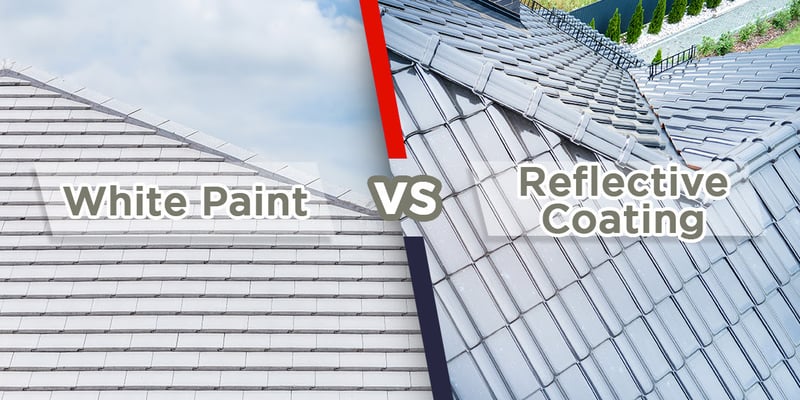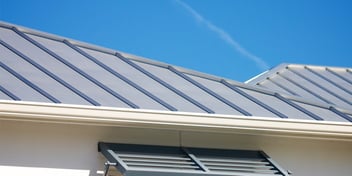- Home »
- Learningcenter »
- White paint reflective coating
White Paint vs Reflective Roof Coating: What's the Difference?

Homeowners and building managers who really want to cut their costs and help the environment can find energy efficiency to be a pretty popular topic these days. Some good cooling services become more of a big deal as temperatures increase. This naturally leads to more interest in options like white paint and reflective roof coatings.
Both of these options try to lower the heat absorption and help with indoor comfort, but they have different purposes with levels of how well they work and what they cost and what maintenance they need. You might find it hard to choose between them - especially if you want to think about the ups and downs of each. When you pick wisely, you can usually give yourself some savings and comfort improvements.
Let's get started!
What Is White Roof Paint?
White roof paint can make the building's roof much brighter and it can also help cut the heating costs.
You can get it in a water-based or an acrylic combination with easy white pigments like RD-Roof White. These pigments really send the sunlight away even when it's cold outside.
You'll often see white roof paint on homes, businesses, or even factories - this paint can be used on flat sloped or even wavy roofs and sends back the sunlight - especially visible and near-infrared rays. It can reflect up to about 89% of the sun's rays. Your roof can work like sunscreen to keep inside temperatures lower, and it can help cut back on your cooling bill. In some hot areas, you might turn down the thermostat by a few degrees. Every degree can help.

The weather can wear out white roof paint over time because of the UV rays, rain and also temperature changes. It might lose its ability to reflect light so you'll need to keep it up. Nobody really likes to see their sun-blocking work fade away. Why let all that sun protection go to waste?
You might want to look at the case studies that show the effects of white roof paint on hotter places. Results show big energy savings from less AC - that feels nice when your next energy bill comes. But this paint isn't the best energy-saving answer as it gives little waterproofing and its reflectivity goes down over time.
When you plan your roofing, remember that reflective coatings sometimes do much better than white roof paint. These coatings give waterproofing strength and long-term reflectivity. They give you long-term energy savings and roof safety. If you want long-term help, reflective coatings could be your best pick.
How Does Reflective Roof Coating Work?
Reflective roof coatings really help with roof maintenance and the energy efficiency of buildings. These coatings, made with reflective minerals, create a tough barrier against environmental wear and tear. You can see them as a strong shield for your roof - one that's weather-proof and ready for nature's challenges.
One nice thing about reflective coatings is their great thickness. Imagine a layer that's five to ten times thicker than regular paint and can expand with the sun's heat without cracking. They're built to last, and it gives a lifespan that simple paint cannot match. You'll find this durability really pays off over time. Temperature changes cannot beat these coatings - they protect against UV damage, water leaks, and friction. That's true toughness!
These coatings also help with the energy efficiency by keeping heat out. Reflective coatings help to cut back on energy costs by reflecting sunlight and minimizing heat absorption. Imagine a commercial building under the sun - a reflective coating can drop cooling costs by up to 30% each year. Now that's quite a saving!

The science behind these coatings is interesting. They have high Solar Reflective Index (SRI) values, which reflect sunlight and heat - they cut back on roof surface temperature by 20 to 50 degrees Fahrenheit. Their thermal emittance property releases absorbed heat back into the air and they keep your building cooler.
In residential areas, these coatings also work super well. When you coat a tin-roof Queenslander with reflective material, it can cool the indoors and extend the roof life by up to 15 years.
So why not think about reflective roof coatings for your building maintenance? Maybe it's time to take a closer look - and give your roof the high-performance help it deserves! Think about the long-term benefits.
Consider Cost and Longevity
You need to think about the costs and the durability when you compare the white paint and reflective roof coatings. White paint - especially the elastomeric type - costs around $15 to $25 per gallon at first - this might look budget-friendly especially for a DIY project but remember that you'll need it again every five to ten years. Over a couple of decades, those early savings might turn into thousands and this could become a regular expense. Choose wisely today for savings tomorrow.
Reflective roof coatings like silicone or EPDM cost more at the start when you range from $1.50 to $11 per square foot for installation. These coatings last 10 to 20 years, and they resist the elements better, so you'll stay away from the regular reapplications. Think of this as an investment spread over time - it's a relief when your wallet isn't always on alert.

Durability is another big factor to think about. White paint has trouble in harsh conditions and it fades under strong sun or heavy rain. Reflective coatings - especially silicone - manage extreme temperatures and UV exposure well. Imagine the peace of mind to know your roof stays efficient for over a decade! Reflective coatings give this reliability and they manage both heat and moisture.
For a common 2,000-square-foot roof, white paint costs $300 to $500 at first. However, over 20 years, reapplications could total $2,000 to $3,000. Reflective coatings start at $3,000 to $9,000 but stay affordable in the long run, so you'll likely see lower energy bills because of better heat reflection.
When you choose what matters to you the most, is keeping your upfront costs low your priority, or does long-term reliability win? Your budget and environmental conditions should help you make your choice. Reflective coatings give toughness and a longer lifespan for a higher first cost. When you pick reflective coatings, it could be a good idea your future self will really like. Quality is an investment in peace of mind.
Are There Environmental Benefits?
When you think about the effects on the environment when you choose between white paint and reflective roof coatings, it helps. Both of these choices can help to cut down on energy use by bouncing sunlight away. Just to give you an example, a white roof can be about 30 degrees cooler than a gray one. That means you'll need to use the AC less - it'll cut electricity use by up to 10% and lower greenhouse gas emissions, too. Think about how this energy saving can help with climate change work. If reflective roofs were used everywhere, it would be like taking 300 million cars off the road for 20 years - that's a big deal!
But there are also some downsides to think about. You'll find that making white paints and reflective coatings uses different chemicals, and some coatings could give you chemical runoff or waste. When you stay away from unwanted pollution, you should choose eco-friendly products that are certified by the Cool Roof Rating Council (CRRC). Nice options that use safe ingredients and ideas like "ultrawhite BaSO4 paints" are promising! When you use certified and environmentally safe materials, it can really help.

These services can cool urban heat islands and lower temperatures - that might delay widespread warming by around 11 years if used quite a bit. But it's not a magic fix and pairing these strategies with other climate actions can give the most help. While India sees big gains in cutting heat-related issues, colder areas might need more heating in winter. But the summer savings usually outweigh these small increases.
Worried about possible downsides? Bright white roofs can give you strong glare - that might annoy neighbors and affect local weather patterns, like less rain. When you think about these points, it helps you make well-educated choices about the environment's pros and cons. Adding these services wisely can help with your commitment to sustainable development - keep the cool savings coming! Little changes today mean big results tomorrow!
What Are Installation and Maintenance Needs?
You need to think about your comfort with DIY tasks and the result you want when you install either white paint or reflective roof coatings. You can put on white roof paint with brushes, rollers, or sprays. You don't need any special skills or professional help, making it a nice choice if you're on a budget or if you like DIY tasks.
But you have to get ready for some downsides, too. White paint needs more touch-ups and doesn't last as long as reflective coatings. You'll need to reapply it and clean it sometimes to keep its solar reflectivity. Imagine cleaning your roof every few months with mild soap. It might keep you active and involved, but it's a commitment.
Reflective roof coatings like elastomeric ones are a different kind of challenge altogether. You can put them on with brushes or sprays, but you might want to call the experts. A perfect application will help give you these coatings to work well! You'd hate to spend all that time and money only to have it peel off too soon because of some missed steps. Accuracy really matters!
You can depend on these coatings to last longer and resist dirt and temperature changes more. They dry out not as fast as paint does. You'll need to plan to clean them to keep them working well, but it's not a giant job. In most cases, a quick clean every few months should do the job efficiently.

Problems are out there for both options. White paint can wear out faster, and reflective coatings need a very clean surface to stick the right way. Not putting together the surface right or skipping maintenance can just give you trouble later with either choice.
You should think about maintenance tips like creating regular checks and cleaning to catch issues early. Mild soaps help keep reflectivity for white paint even though it doesn't last as long. A maintenance plan from your installer can help reflective coatings work well for years.
When you weigh your DIY interest against the long-term results you hope to achieve both options need care and attention but reflective coatings might give you more peace of mind and less touch-ups later on.
Does Climate Affect Performance?
Your local weather can tip the scales when you're looking at your choices between white paint and shiny roof coatings. In hot places like Los Angeles or Arizona, you'll see that the shiny coatings can really cut down cooling costs. You'll walk into a cooler home and see your energy bill go down as the surfaces stay cooler. On the other hand, ultra-white paint could lower surface temperatures by 8 to 19 degrees Fahrenheit! You'll save on energy bills with that difference, which means more money in your pocket.
You'll turn up the heat more often in the colder places. But the shiny surfaces can raise heating costs when they reflect more heat than they take in. In some cities, the winters will take a big bite out of your heating bill. The white roofs might not give you the savings you're wanting in these areas so you need to carefully weigh the pros and cons.
The humidity also matters. In wet places like the Southeastern United States, moisture can slowly wear down the best of paint and coatings over time. Fortunately, Purdue's special ultra-white paint seems to hold up even when the skies are gray. You'll not worry as much about mildew or less cooling on those rainy days - that's a nice thought. Steady performance in changing weather is important.

You'll need some extra protection in desert areas with the regular winds. You don't want that shiny surface to lose its best and not work well. The Harbin team is testing a new chameleon coating for these tough places - that's worth keeping an eye on. Innovation could change everything.
The mild climates like the Midwest can gain from coatings that change with the seasons. These areas reflect heat in summer and take it in during winter - this way can balance the year-round comfort and energy use challenge. That leads to optimal efficiency.
When you think about which coating fits your preferences, it helps to match your choice with the expected long-term results. When you learn how weather and roofing materials work together, it has a custom way to manage comfort and costs through the seasons. The goal is better decisions for long-term comfort.
Protect The Roof Over Your Head
Options have their own sets of pros and cons and you need to really think about these when you want to protect your home or building. Maybe you like the easy beauty of a fresh layer of white paint or you could like the strong durability and energy-saving benefits of a reflective coating. Choose wisely!
When you have to think about how much effort you're willing to put into maintenance over the years, white paint needs more regular touch-ups to keep its look and effectiveness. Reflective coatings, even though they are more expensive upfront, give you longer-term peace of mind. Do you see a roof that quietly and efficiently lowers your energy bills while withstanding harsh weather? Reflective coatings give you that level of assurance - going past basic paint insulation and weather-proofing! These choices make a strong case for themselves based on your priorities regarding cost, strength, and environmental results.
Climate things are important in your choice because they play a giant role in effectiveness. Are you in a hot area where good cooling services are important, or do you live somewhere with wet weather that might affect less tough coatings? You need to think about how climate facts use your roofing choice. Your choice will have a long-term effect on energy bills, comfort, and carbon footprint. The right choice today can save you money tomorrow.

Colony Roofers is here to help when you need expert advice. We provide expert commercial and residential roofing services. Based in Georgia, Florida, and Texas, we're right in your area and are happy to help. Protect your home and its worth with expert care - it's our job, so trust us with your roof repair needs to make sure it gets the care it deserves. Contact us today for a free inspection and choose Colony Roofers - a partner dedicated to keeping your roof in good shape for years to come!
 Call (678) 365-3138
Call (678) 365-3138


